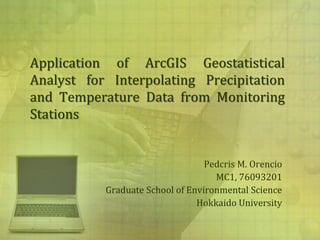
Climate Variables
- 1. Application of ArcGIS Geostatistical Analyst for Interpolating Precipitation and Temperature Data from Monitoring Stations Pedcris M. Orencio MC1, 76093201 Graduate School of Environmental Science Hokkaido University
- 2. Introduction • Monitoring stations such as weather stations collect information on precipitation and temperature to determine climatological changes • Geographical Information System (GIS) provides the means for the management, visualization and analysis of the monitored data • ArCGIS geostatistical analyst tool can be used for spatial exploration and surface information generation from discrete points using statistical methods
- 3. What is Interpolation? • interpolation is a method of constructing new data points within the range of a discrete sets of known data points. • it can either be deterministic or probabilistic. • Deterministic methods create a continuous surface by only using the geometric characteristics of point observations or mathematical computations. (example: IDW) • Probabilistic methods are based on probabilistic theory and use the concept of randomness, and include the variance in the process of computing the statistical significance of the predicted values to establish cetainty. (example: Kriging)
- 4. Objectives and Purpose • Understand the capability of some tools in ArcGIS Geostatistical Analyst in interpolating monitoring data into spatial form • Define the trends or the shift in seasonal precipitation and temperature changes (during Winter, Spring, Summer and Autumn) in Hokkaido • Understand the concentration areas of temperature and precipitation and identify spatially, the local maxima and minima for each seasons
- 5. Methodology • Gather secondary data from JMA • 154 stations in Hokkaido (AMEDAS and Weather Stations) • 1971 to 2000 average precipitation and temperature • Data processing and assumption setting • Data manipulation using ArcGIS Geostatistical Analyst • Elevation using Inverse Distance Weighting • Average Precipitation and Temperature per Season using Cross Validation and Kriging Methods • Data Analysis • Overlay of Elevation Maps, Average Temperature and Precipitation Maps
- 6. Process Flow Secondary data gathered from JMA (http://www.data.jma.go.jp) Data processing using MS Excel • Station • Bearing (Latitude & Longitude) • Elevation •Precipitation and Temperature Averages (Monthly Average of 1971- 2000 data) Data manipulation using ArcGIS Map form for overlay and analysis
- 7. Preparing the Thematic Maps Elevation and Average Average Stations Bearing Precipitation per Temperature per Month Month (1971- 2000) (1971- 2000) Elevation and W S S A W S S A Stations Bearing i p u u i p u u n r m t n r m t t i m u t i m u e n e m e n e m r g r n r g r n Interpolation Data Base Map Thematic Map Method
- 8. Hokkaido Sampled Weather Stations
- 9. Hokkaido Map of Weather Stations Sapporo Base Map: ArcGIS 9 ESRI Data & Maps 9.3 Coordinate System: GCS_JGD_2000
- 10. Elevation using Interpolation (IDW) 5 Color Class limits Classes (Elevation) Highest 432- 540 Nukabira High 324- 432 Mid 216- 324 (540 m) Low 108- 216 Lowest 0- 108 in meters Inverse Distance Weighting (IDW) is a quick deterministic interpolator that is exact. There are no assumptions required of the data- no assessment of prediction errors, thus IDW can produce "bulls eyes" around data locations
- 11. Estimated Ave. Precipitation by Season Precipitation Ave. in mm. Seasons (1971 to 2000) Highest Class Limit Lowest Class Limit Winter (November to March) 175.92- 196.5 31.90- 52.47 Spring (April to June) 154.84- 170.50 45.27- 60.92 Summer (July to August) 290.25- 320.80 76.40- 106.95 Autumn (Sept to October) 275.85- 303.25 84.05- 111.45
- 12. Trends in Ave. Precipitation by Season (Kriging) High Autumn Winter Low Spring Summer
- 13. Estimated Ave. Temperature by Season Temperature Ave. in °C. Seasons (1971 to 2000) Highest Class Limit Lowest Class Limit Winter (November to March) 0.99- 2.10 -6.80- -5.69 Spring (April to June) 11.15- 11.87 6.13- 6.85 Summer (July to August) 20.18- 21.30 12.35- 13.47 Autumn (Sept to October) 15.70- 16.60 9.40- 10.30
- 14. Trends in Ave. Temperature by Season (Kriging) High Autumn Winter Low Spring Summer
- 15. Analysis Using Map Overlays • Seasonal Ave. Precipitation by Elevation (example: Average Precipitation in Autumn) Darker shade means higher average precipitation while lighter shade means lower average precipitation
- 16. Analysis Using Map Overlays • Seasonal Ave. Temperature by Elevation (example: Average Temperature in Winter) Decrease in shade of color of elevated areas means that there is low average temperature in these areas while increase in shade means higher temperature
- 17. Analysis Using Map Overlays • Precipitation-Temperature Relationships (example: Spring Season) Darker shade of colors means that there are higher average temperature in higher average precipitation
- 18. Seasonal Ave. Precipitation by Elevation Autumn Winter Spring Summer
- 19. Seasonal Ave. Temperature by Elevation Autumn Winter Spring Summer
- 20. Precipitation-Temperature Relationship Autumn Winter Spring Summer
- 21. Summary • Climatic data map have varying degrees of utilization • Land and environmental conservation, production, management • ArcGIS Geospatial Analyst can be used to produce spatial representation of monitored data using interpolation methods • Desirable in establishing trend (Kriging method) • Calculating spatial pattern in identifying mean or median in large areas (IDW method) • The quality of produced maps are influenced by a number of factors as this determines the capability of the technique estimation in interpolating the surface • Reliability of the data sets gathered from the points and the other factors that affects the samples measured • Frequency and distance of the points from one another
